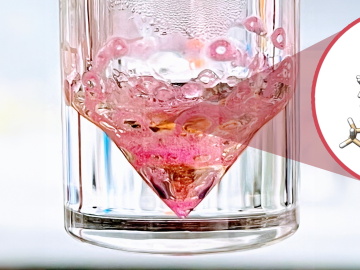
Filter News
Area of Research
News Topics
- Big Data (1)
- Computer Science (10)
- Cybersecurity (1)
- Exascale Computing (2)
- Frontier (3)
- Fusion (1)
- High-Performance Computing (3)
- Isotopes (1)
- Machine Learning (1)
- Materials (2)
- Materials Science (4)
- Microscopy (1)
- Nanotechnology (2)
- Neutron Science (1)
- Physics (3)
- Quantum Computing (22)
- Quantum Science (27)
- Security (1)
- Simulation (5)
- Summit (2)
Media Contacts

For the first time, ORNL will run equipment developed at its research facilities on a commercially available quantum network at EPB Quantum Network powered by Qubitekk to help validate the technology's commercial viability.

The Quantum Computing User Forum welcomed attendees for a dynamic event at ORNL. The annual user meeting brought the cohort together to highlight results and discuss common practices in the development of applications and software for quantum computing systems.
The University of Tennessee at Chattanooga and the Department of Energy’s Oak Ridge National Laboratory are entering into a memorandum of understanding with the intent to collaborate in efforts to research, develop, deploy and evaluate technology and analytically based solutions to challenges in the area of quantum information science and engineering, including networking, sensing, and computing.

Researchers conduct largest, most accurate molecular dynamics simulations to date of two million correlated electrons using Frontier, the world’s fastest supercomputer. The simulation, which exceed an exaflop using full double precision, is 1,000 times greater in size and speed than any quantum chemistry simulation of it's kind.

Researchers used quantum simulations to obtain new insights into the nature of neutrinos — the mysterious subatomic particles that abound throughout the universe — and their role in the deaths of massive stars.
Close on the heels of its fourth summer school, the Quantum Science Center, or QSC, hosted its second in-person all-hands meeting in early May. More than 150 scientists, engineers and support staff traveled from 17 institutions to review the QSC’s progress, examine existing priorities and brainstorm new short- and long-term research endeavors.

Purdue University hosted more than 100 attendees at the fourth annual Quantum Science Center summer school. Students and early-career members of the QSC —headquartered at ORNL — participated in lectures, hands-on workshops, poster sessions and panel discussions alongside colleagues from other DOE National Quantum Information Science Research Centers.

A team from ORNL successfully characterized a coordination complex of the element Promethium. The research was supported by computational simulations of the element's electronic structure run on the IBM AC922 Summit supercomputer.

A team of researchers including a member of the Quantum Science Center at ORNL has published a review paper on the state of the field of Majorana research. The paper primarily describes four major platforms that are capable of hosting these particles, as well as the progress made over the past decade in this area.

ORNL scientists are working on a project to engineer and develop a cryogenic ion trap apparatus to simulate quantum spin liquids, a key research area in materials science and neutron scattering studies.


